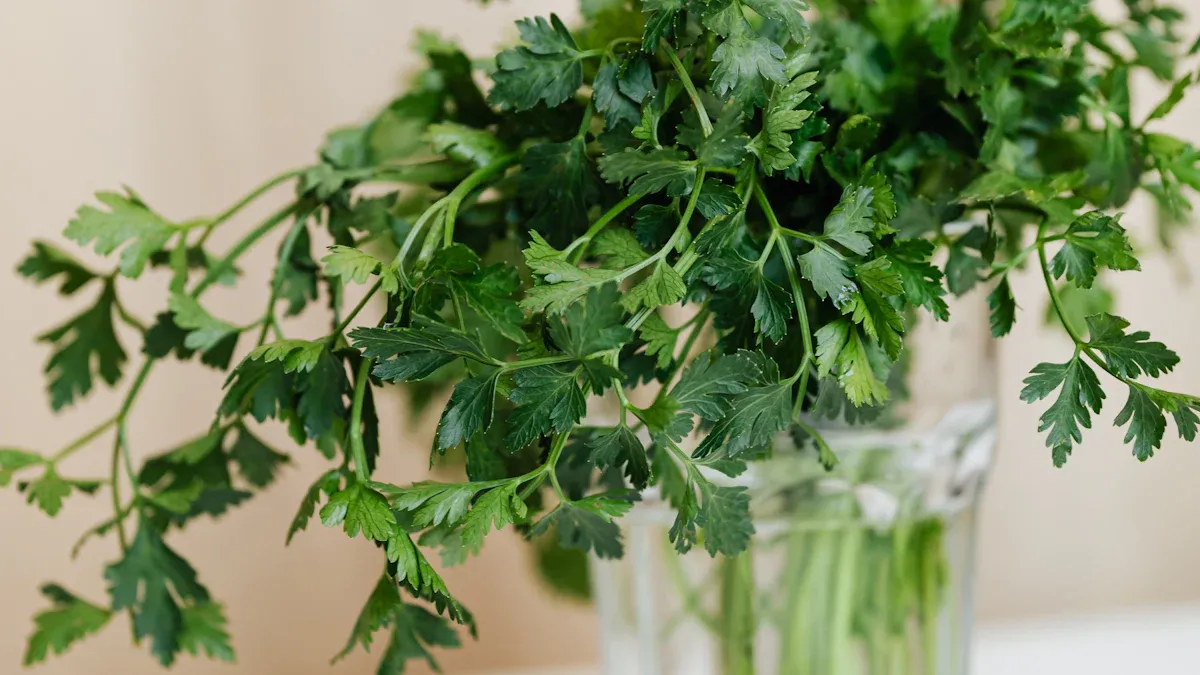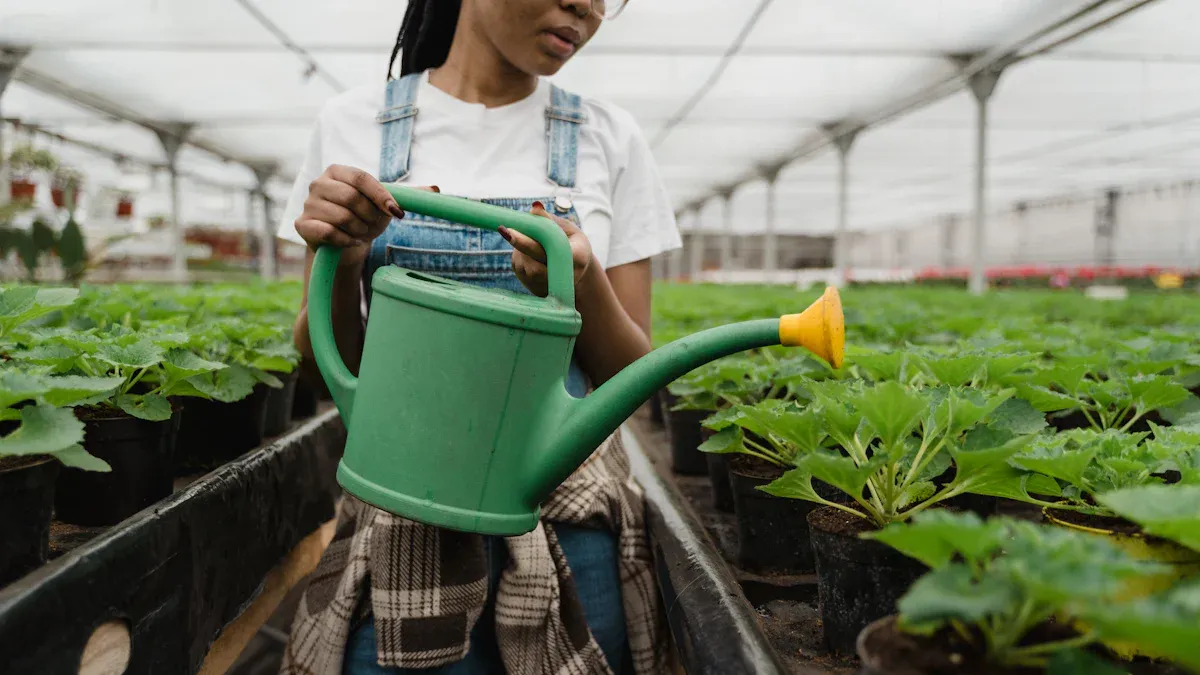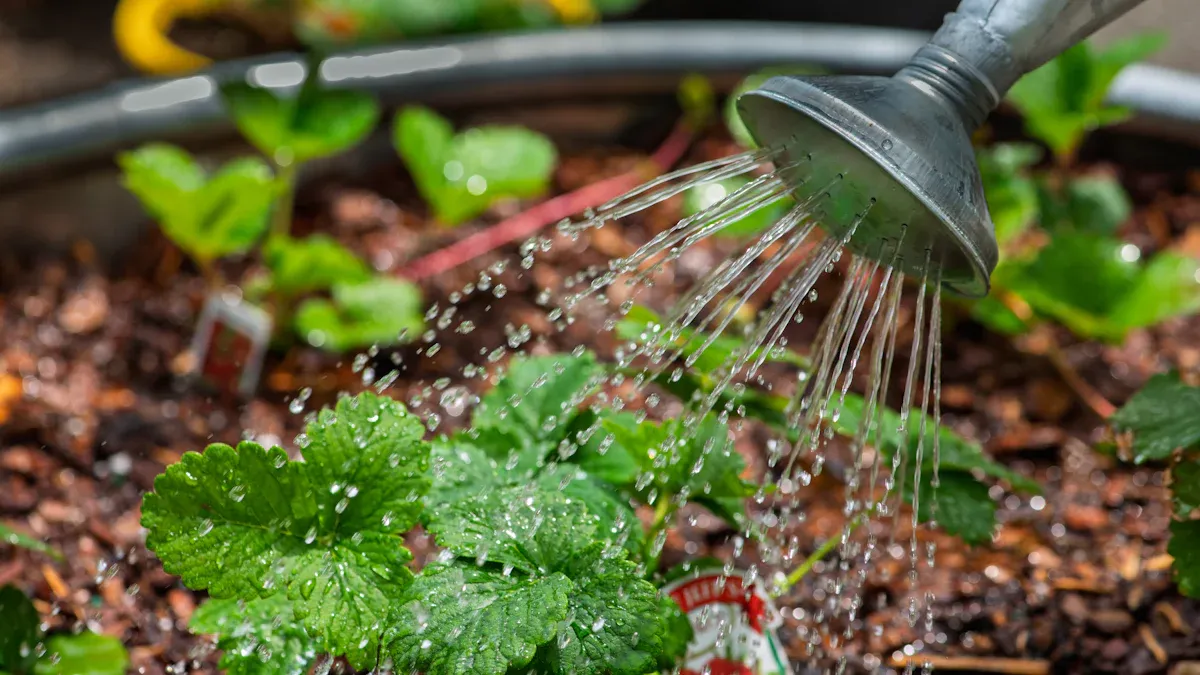
Coriander plant watering is essential for their thriving growth. Generally, these plants need about one inch of water each week, which includes rainfall and any additional watering. During the growing season, you’ll want to focus on coriander plant watering weekly, but if it gets particularly hot or dry, you might need to adjust your routine. After they mature, a small sip of water once a week will keep them happy.
Key Takeaways
Coriander plants need about one inch of water each week to thrive.
Adjust your watering frequency based on the season; water more in summer and less in winter.
Use tools like a rain gauge or soil moisture meter to monitor soil moisture effectively.
Watering Frequency

Daily and Weekly Needs
When it comes to coriander plant watering, you want to strike the right balance. Generally, you should water your coriander plants deeply about 1-2 times per week. This schedule can vary based on rainfall and environmental conditions. Here are some key points to keep in mind:
Water deeply to encourage strong root growth.
Keep the soil consistently moist but not waterlogged.
Aim to maintain about one inch of moisture around the base of the plant at all times.
If you notice the top couple of inches of soil drying out, it’s time to give your plants a drink. Remember, watering cilantro regularly helps keep the plants healthy and vibrant.
Seasonal Adjustments
As the seasons change, so do your watering needs. During the summer months, when temperatures soar, you might need to increase your watering frequency. Here’s what to consider:
In summer, water more frequently to combat evaporation and heat stress. Check the soil daily, especially during heat waves.
In winter, maintain consistent soil moisture without overwatering. Overwatering can lead to damping-off disease, which can be detrimental to young plants. Watering early in the morning can help minimize the risk of fungal diseases.
Once your coriander plants are established, water them deeply but less frequently. This approach promotes robust root development. Regularly monitor soil moisture by checking 2-3 inches deep; if it feels dry at that depth, it’s time to water again.
Expert recommendations emphasize that the need for adequate moisture varies significantly across agricultural regions. Factors like soil fertility and climate play a crucial role in maximizing crop yield, especially during key growth stages like flowering and seed setting. So, adjust your watering routine based on your local conditions to ensure your cilantro plants thrive.
Water Amount

Measuring Water for Coriander
When it comes to coriander plant watering, knowing how much water to provide is crucial. Generally, you should aim for about 1 inch of water per week. This amount applies whether your plants are in the ground or in containers. Here’s how you can effectively measure the water:
Use a Rain Gauge: Place a rain gauge in your garden to track how much water your plants receive from rainfall. This helps you adjust your watering schedule accordingly.
Soil Moisture Meter: Invest in a soil moisture meter. This handy tool gives you a clear reading of the moisture level in the soil, helping you determine when to water.
Finger Test: Stick your finger about 2-3 inches into the soil. If it feels dry at that depth, it’s time to water.
Water Quality Parameter | Importance for Coriander Plants |
|---|---|
Alkalinity | Affects nutrient availability and soil pH. |
pH | Controls nutrient solubility and availability. |
Hardness | Indicates mineral content that can affect plant health. |
Salinity | High levels can lead to osmotic stress in plants. |
Electrical Conductivity | Reflects the total dissolved salts, impacting growth. |
Signs of Water Issues
Understanding the signs of overwatering and underwatering can save your coriander plants from stress. Here’s what to look for:
Overwatering Signs:
Yellowing Leaves: If the lower leaves turn yellow, it might indicate nutrient deficiencies caused by root damage.
Wilting: You might notice wilting even when the soil is moist. This happens because the roots can’t transport water effectively.
Edema: Look for raised, watery blisters on leaves. This condition occurs when the plant absorbs too much water.
Brown Leaf Tips: If the tips of the leaves turn brown and feel soft, it’s a sign of overwatering.
Underwatering Signs:
Wilting Plants: If your plants droop and look lifeless, they may need water.
Reduced Yield: Underwatered cilantro plants often produce fewer leaves and seeds.
Maintaining the right balance in watering cilantro is essential for healthy growth. By monitoring these signs, you can adjust your watering routine to keep your plants thriving.
Factors Affecting Coriander Plant Watering
Climate Considerations
Your coriander plants’ water needs can change based on the climate. They thrive in cooler temperatures and require regular watering to keep the soil consistently moist. If you live in a hot climate, your plants might bolt, which means they go to seed prematurely. Here are some tips to consider:
Monitor Temperature: During hot spells, increase your watering frequency to prevent stress.
Adjust for Rainfall: If you get rain, reduce your watering to avoid waterlogging.
Watch for Drought: In dry conditions, be vigilant. Drought stress can significantly impact growth, especially during critical stages like seed filling.
Soil Type and Drainage
The type of soil you use plays a crucial role in how well your coriander plants retain moisture. Coriander prefers well-drained soil with a pH between 6.2 and 6.8. Here’s how to ensure your soil is just right:
Incorporate Organic Matter: Adding compost improves soil structure and nutrient content, helping retain moisture.
Enhance Drainage: Mix in materials like sand or perlite to prevent root rot. Good drainage is essential because coriander doesn’t tolerate waterlogged conditions.
Regular Checks: Keep an eye on soil moisture. Water when the top inch feels dry, and remember that established cilantro plants need less water than young ones.
By understanding how climate and soil type affect your watering practices, you can help your cilantro plants thrive.
Tips for Effective Watering
Best Practices
To keep your coriander plants healthy, follow these best practices for watering:
Allow Soil to Dry: Let the soil dry out completely before watering again, especially if your plants are in containers. This helps prevent root rot.
Use the Finger Test: Check moisture levels by inserting your finger into the soil up to the first or second knuckle. If it feels dry, it’s time to water.
Water Weekly: Aim to water cilantro approximately once a week. Adjust this based on rainfall and dry conditions.
Watch for Signs: Look for crispy leaves as a sign of insufficient water and yellowing leaves as an indication of overwatering.
Avoid common mistakes like letting pots dry out between waterings. Using mulch can help retain moisture and prevent stress on your plants. Ensure even moisture levels to avoid bolting, which can happen with uneven watering.
Tools and Techniques
Using the right tools can make watering your coriander plants easier and more effective. Here are some recommendations:
Drip Irrigation System: This system operates on a timer, allowing for better control over water usage. It minimizes evaporation and directs water precisely to the roots.
Watering Cans: They provide control over water application, making them ideal for small gardens and delicate seedlings.
Automatic Timers: These help you water at optimal times, ensuring your plants get the moisture they need without overdoing it.
Tool Type | Benefits |
|---|---|
Watering Cans | Control over water application, ideal for small gardens and delicate seedlings. |
Automatic Timers | Increase efficiency, minimize evaporation, and deliver water directly to plant roots. |
Drip-watering Irrigation System | Controls water usage, minimizes evaporation, and directs water precisely to the soil. |
By following these tips and using the right tools, you can ensure your coriander plants thrive with the right amount of moisture.
In summary, understanding how much water your coriander plants need is vital for their success. Here are some key takeaways:
Coriander requires ample moisture, especially when young.
Regular watering prevents bolting, ensuring a steady supply of leaves.
Overwatering can lead to root rot, harming your plants.
By keeping the soil evenly moist, you’ll enjoy a bountiful harvest of fresh cilantro! 🌱
FAQ
How much water cilantro needs during hot weather?
Cilantro needs more water in hot weather. Check the soil daily and water if it feels dry.
Can I use tap water for my coriander plants?
Yes, you can use tap water. Just let it sit for a few hours to allow chlorine to dissipate.
What should I do if my cilantro leaves are wilting?
If your cilantro leaves are wilting, check the soil moisture. Water if it feels dry, but avoid overwatering.

